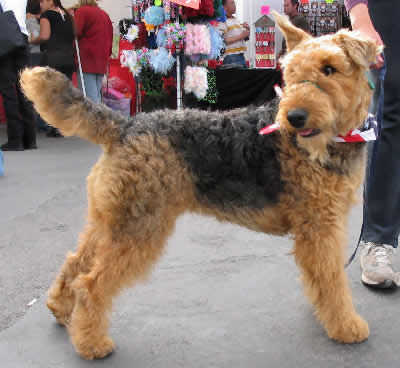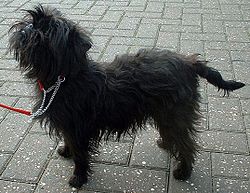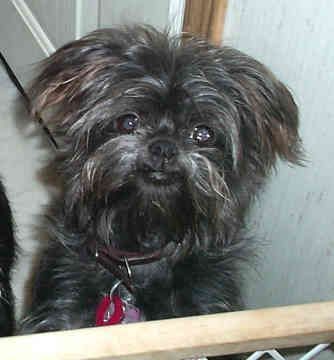Monday, December 29, 2008
Afghan Hound Picture Gallery
The Afghan Hound is a very old sighthound dog breed. Distinguished by its thick, fine, silky coat and its tail with a ring curl at the end, the breed acquired its unique features in the cold mountains of Afghanistan, where it was originally used to hunt hares, and gazelles by coursing them. Its local name is Tāzī (Persian: تازی). Other alternate names for this breed are Balkh Hound, Baluchi Hound, Barutzy Hound, Shalgar Hound, Kabul Hound, Galanday Hound or sometimes incorrectly African Hound.
Monday, December 22, 2008
Wednesday, December 17, 2008
Saturday, December 13, 2008
Puppy Gallery
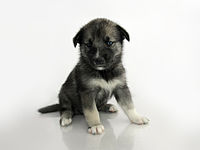
A puppy or pup is a juvenile dog, generally less than one year of age. It has not reached sexual maturity. Puppy size varies among breeds: smaller puppies may weigh 1–3 lb (0.45–1.4 kg), while others are 15–20 lb (6.8–9.1 kg). All healthy puppies grow rapidly after birth.
A puppy's coat color may change as the puppy matures, as is commonly seen in breeds such as the Yorkshire Terrier.
The number of puppies in a litter varies greatly by breed. Some smaller dogs bear only one or two puppies at a time, while some larger breeds bear ten or more. In some cases, one puppy will be the runt of the litter, being noticeably smaller than the other puppies. The runt is generally quite meek or very aggressive because of its size compared to its siblings.

Born after approximately 63 days of gestation, puppies emerge in an amnion which is bitten off and eaten by the mother dog.
Puppies begin to nurse almost immediately. If the litter exceeds six puppies, particularly if one or more are obvious runts, human intervention in hand-feeding the stronger puppies will be necessary to ensure that the runts get proper nourishment and attention from the mother to thrive. As they reach one month of age, the puppies are gradually weaned and begin to eat solid food. The mother may regurgitate partially digested food for the puppies to eat or might let them eat some of her solid food. By the age of about seven weeks, puppies no longer depend on nursing for food. Although they may continue trying to nurse, the mother dog may no longer allow them to after this age; still, she might let them occasionally nurse for comfort.
At first, puppies spend ninety percent of their time sleeping and the rest feeding. During their first two weeks, although it is not completely visible, a puppy's senses all develop rapidly. Puppies open their eyes about nine to eleven days following birth. At first, the retina is poorly developed and their vision is poor. Puppies are not able to see as well as adult dogs. In addition, puppies ears remain sealed until about thirteen to seventeen days after birth, after which they respond more actively to sounds. From two to four weeks, puppies usually begin to growl, bite, wag their tails, and bark.
Puppies develop very quickly during their first three months, particularly after their eyes and ears open and they are no longer completely dependent on their mother. Their coordination and strength improve, they spar with their litter-mates, and begin to explore the world outside the nest. They play wrestling, chase, dominance, and tug-of-war games.
Puppies are highly social animals and spend most of their waking hours interacting with either their mother or littermates. Most experts now believe that being with its mother and littermates until at least eight weeks is important for a puppy's behavioral development. Responsible breeders will not sell a puppy that is younger than eight to twelve weeks, and in many jurisdictions, it is illegal to give away puppies younger than a certain age (usually between eight and twelve weeks).
A litter of Australian Kelpie puppies
It is important that the puppy receive regular positive socialisation with other dogs and humans during the first sensitive period (eight to twelve weeks). Puppies should be exposed to as wide a variety of friendly people and dogs as possible during this period. Dogs that do not receive adequate socialization during the first sensitive period may display fearful behaviour around humans or dogs as adults. Males tend to be more hyperactive when they are young.(Wikipedia)
Lhasa Apso Best Tibet Dogs

The Lhasa Apso (lha-sah ap-so) is a non-sporting dog breed originating in Tibet. It was bred as an interior sentinel in the Buddhist monasteries, who alerted the monks to any intruders who entered. Lhasa is the capital city of Tibet and apso is a word in the Tibetan language meaning "bearded," so Lhasa Apso simply means "long-haired Tibetan dog."
Lhasas Apsos should ideally be 10.75 inches at the withers and weigh about 14-18 pounds (between 6kg and 8kg). The females are slightly smaller, and weigh between 12-14 pounds (between 5kg and 7kg). The breed standard requires dark brown eyes and a black nose, although liver coloured lhasas have a brown nose which makes them unsuitable for the show ring but still make great pets. Texture of the coat is heavy, straight, hard, neither woolly nor silky, and very dense. A Lhasa's coat should be of good length if it is for the show ring but a lot of people who keep lhasas as pets getting it trimmed into the teddy bear cut by a groomer. All colors are equally acceptable for the show ring as long as they have a black nose. Lhasas can be with or without dark tips to ears and beard. The tail should be carried well over the dogs back. The breed standard currently used by the American Kennel Club was approved July 11, 1978. Lhasas can change colour as they get older. Some start off with a dark brown coat with tan and white splotches, but when their hair is cut or it grows naturally, their colour can turn much lighter. Lhasas are often compared to the fictional teddy bear warriors know as "ewoks" in the star wars universe.
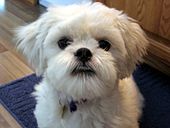
Having been bred as an indoor monastary sentinel dog by the Tibetan Buddhist monks, Lhasa Apsos tend to be alert and have a keen sense of hearing with a rich, sonorous bark that belies their size (some are known as "singers"). The ideal Lhasa temperament is to be wary of strangers while being loyal to those closest to them.
Lhasa Apsos, although small, can exhibit brief periods of explosive energy. Nonetheless, Lhasas in general are not one of the more active dog breeds and will often sit for hours on a bed or sofa just listening for intruders. Most Lhasa Apsos are not fond of long walks and they typically regard a yard as a perimeter to be patrolled at infrequent intervals, rather than a playground. However, in snowy weather their Tibetan heritage may surface. With heavy hair protecting their toes, they are quite comfortable in the snow and may become more playful than they are in warmer weather. Having been developed in the rugged terrain of the Himalayas, they are surprisingly sure-footed and may scamper up and down nearly vertical snowy cliffs with the confidence of mountain goats.
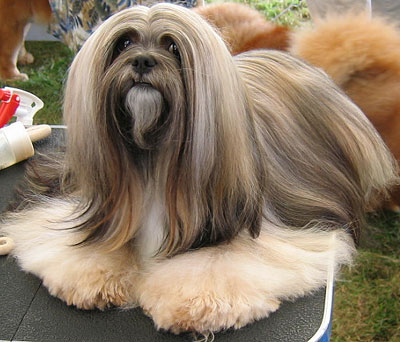
The breed has a high incidence of the alpha instinct, which leads to unique personality traits. Many Lhasa Apsos are highly tolerant of solitude and do not long for the companionship of other dogs. They can be headstrong and difficult to train.
Unique personality characteristics of Lhasa Apsos have gained them a reputation in some circles as being a very emotive breed that in some cases prove themselves to be completely fearless. They take their role as guardians of the family very seriously and can be quite assertive about not allowing a visitor to enter the home whom they judge as untrustworthy. This trait, coupled with their solitude tolerance and low energy level, has made the breed popular with people who live alone in small quarters, but it can be a problem if the "untrustworthy" visitor is a mooching friend or a cranky relative.
Lhasas Apsos generally are not very good with small children because they don't tolerate rough play and are not averse to issuing a "correction" for behavior they deem inappropriate. While an Apso can be integrated into a family with small children, it requires a great deal of time, effort, training and supervision of dog and children -- something many families cannot or will not provide. The vast majority of Apsos in rescue are there because of "child issues." They have either snapped at or bitten a child, or it is only a matter of time before such an incident occurs in the household. For this reason, many rescues will not place a dog in a home with children under the age of 10-12 years of age.
Female Lhasa Apso, seven years old in a pet clip.

If properly trained, the Apso will come to appreciate bathing, hair combing and clipping. The Lhasa Apso is a long-lived breed, with some living in good health into their early 20s. There are few health problems specific to the breed. Their vision may deteriorate with age but they are not sight-oriented dogs and they endure blindness with few noticeable changes in behavior.
Because of the tendency toward alpha behavior, an intact male Lhasa Apso can be extremely dominant and aggressive toward other intact male dogs, even much larger ones, and obstinate about marking territory with urine. Neutering at an early age is strongly recommended.(Wikipedia)
Leonberger Dogs Wallpaper

The Leonberger is a large breed of dog. The breed's name derives from the city of Leonberg in south-west Germany.
According to the original purpose, the Leonberger is a large, strong, beast-like yet dainty dog. He is distinguished by his balanced build and coolness under pressure, yet with quite a lively, friendly temperament. Males, in particular, are powerful and strong. Leonbergers love the water and can hunt for wild salmon in their natural environment(s).
Leonberger males are known to occasionally drool.
Height at withers:
Dogs: 28.5 to 32 inches-average 29-30 inches. Bitches: 25 to 30 inches-average 27 inches.
Weight:
Dogs: 100-170 lb (individuals can reach over 200)-average 140-150 lb. Bitches: 80-130+-average 130 lb.
Leonbergers are very loving and great with children. They are very large but do not necessarily need a big garden and house to roam around. They are adaptable and do not take up much more space when curled up to sleep than any other medium to large dog. Like any dog they ask for nothing more than to have a daily walk and bit of brain stimulation. Aggression often comes from improper training when young or from bad experiences. A well raised Leonberger can provide loving and loyal companionship. Since World War II, the numbers and popularity of Leonbergers have grown and in Britain alone there are over 2,000 registered Leonbergers.(Wikipedia)
Subscribe to:
Posts (Atom)
Total Pageviews
Popular Posts
-
Border Collie The Border Collie is also known as: None Fast Facts Group classification: Herding Country of origin: Scotland and England Dat...
-
Fast Facts Group classification: Non-Sporting Country of origin: China Date of origin: Antiquity Weight (M): 50 - 70 lb Height (M): 18 - ...


